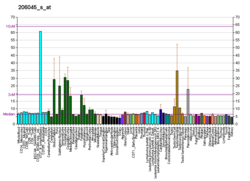| NOL4 |
|---|
|
| Identifiers |
|---|
| Aliases | NOL4, CT125, NOLP, HRIHFB2255, nucleolar protein 4 |
|---|
| External IDs | OMIM: 603577; MGI: 2441684; HomoloGene: 36142; GeneCards: NOL4; OMA:NOL4 - orthologs |
|---|
| Gene location (Human) |
|---|
 | | Chr. | Chromosome 18 (human)[1] |
|---|
| | Band | 18q12.1 | Start | 33,851,100 bp[1] |
|---|
| End | 34,224,952 bp[1] |
|---|
|
| Gene location (Mouse) |
|---|
 | | Chr. | Chromosome 18 (mouse)[2] |
|---|
| | Band | 18|18 A2 | Start | 22,826,238 bp[2] |
|---|
| End | 23,174,710 bp[2] |
|---|
|
| RNA expression pattern |
|---|
| Bgee | | Human | Mouse (ortholog) |
|---|
| Top expressed in | - middle temporal gyrus
- buccal mucosa cell
- endothelial cell
- Brodmann area 23
- ganglionic eminence
- islet of Langerhans
- entorhinal cortex
- superior frontal gyrus
- primary visual cortex
- ventricular zone
|
| | Top expressed in | - Rostral migratory stream
- ventromedial nucleus
- anterior amygdaloid area
- lateral septal nucleus
- primary motor cortex
- habenula
- prefrontal cortex
- cingulate gyrus
- subiculum
- arcuate nucleus
|
| | More reference expression data |
|
|---|
| BioGPS |  | | More reference expression data |
|
|---|
|
| Orthologs |
|---|
| Species | Human | Mouse |
|---|
| Entrez | | |
|---|
| Ensembl | | |
|---|
| UniProt | | |
|---|
| RefSeq (mRNA) | NM_001198546
NM_001198547
NM_001198548
NM_001198549
NM_001282527
|
|---|
NM_003787
NM_001353232
NM_001353233
NM_001353234
NM_001353235
NM_001353236
NM_001353237
NM_001384467
NM_001384468
NM_001384469
NM_001384470
NM_001384471
NM_001384472
NM_001384473 |
| NM_001161483
NM_199024
NM_001347509
NM_001347510
NM_001361223
|
|---|
NM_001361224
NM_001361225 |
|
|---|
| RefSeq (protein) | NP_001185475
NP_001185476
NP_001185477
NP_001185478
NP_001269456
|
|---|
NP_003778
NP_001340161
NP_001340162
NP_001340163
NP_001340164
NP_001340165
NP_001340166 |
| NP_001154955
NP_001334438
NP_001334439
NP_950189
NP_001348152
|
|---|
NP_001348153
NP_001348154 |
|
|---|
| Location (UCSC) | Chr 18: 33.85 – 34.22 Mb | Chr 18: 22.83 – 23.17 Mb |
|---|
| PubMed search | [3] | [4] |
|---|
|
| Wikidata |
| View/Edit Human | View/Edit Mouse |
|


















